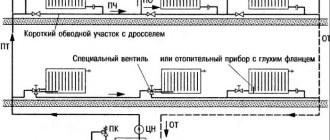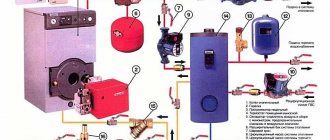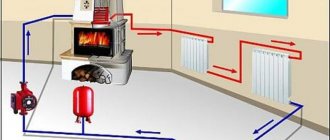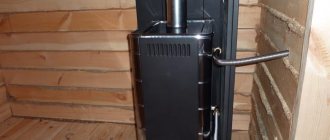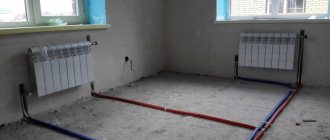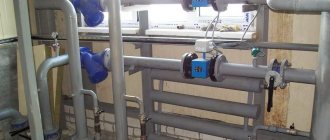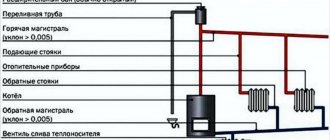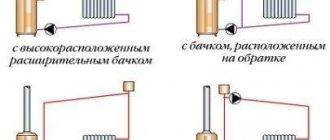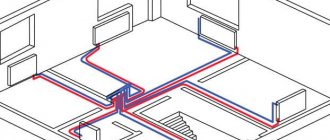Combination of two-pipe and single-pipe options
In private two-story (or higher) houses, both two-pipe and single-pipe vertical risers can be used, along with horizontal single-pipe distribution to rooms with a variety of ways to connect heating devices.
Diagram of a single-pipe heating system for a 2-story house.
The temperature difference in room radiators in this case is calculated by the formula ∆T_р=∆T⁄P, where P is the number of heating devices connected in series (in this case P=3). A horizontal single-pipe main must carry P times more liquid than through horizontal pipes with a two-pipe distribution. This will require an increase in pump power for its forced circulation and high energy costs, but the hydraulic stability of the circuit will be high.
Single-pipe heating system Leningradka (diagram).
When it is necessary to heat a small room, an acceptable option would be to use a system with one ring pipeline (no more than 5 batteries in a ring). This scheme is simple to arrange and economical in terms of materials. The design of the Leningradka is connected heating devices by a single pipe.
The heat source is the boiler. The batteries are mounted around the perimeter of the room. It is possible to arrange the pipeline according to the upper and lower principle. In the lower structure a pump is required, and in the upper one there is a liquid acceleration section.
Single-pipe heating system Leningradka. Scheme.
The main pipe in Leningradka is located in two options:
- Most often it is installed horizontally. All radiators are mounted along the walls in the same plane. Most often, circulation is carried out forcedly, under the action of a pump. A diagonal connection is also possible in this system.
Diagonal connection diagram for a one-pipe heating system - The single-pipe Leningrad heating system can also be installed vertically.
Horizontal diagram.
Single-pipe heating system Leningradka. This type is most often used in two-story houses with a small area. It is possible to use natural and forced circulation of the coolant. Making a vertical scheme with gravity circulation is quite difficult in practice.
Single-pipe heating system for a two-story private house.
The main must be installed at the top of the wall at the desired angle in the direction of coolant flow. For productive operation of this scheme, the boiler must be located below the level of the installed batteries.
Considering the Leningradka system with forced and natural circulation, it is worth saying that organizing a gravitational scheme is much more difficult to implement.
Its use is justified in small one-story buildings; in others, its use may be associated with a number of problems.
Slope diagram of a single-pipe heating system in Leningrad
In addition, it is necessary to make an accurate calculation of the slope angles and select pipes of the required diameter (their diameter is always larger than when using forced circulation) and a certain length. In a gravity-flow boiler, it should be located below the line of radiators, that is, it assumes the presence of a basement under the room. And the expansion tank should be installed in an insulated attic.
Among the most significant problems of a system with natural circulation, the following are worth noting:
1. Radiators on the first floor always heat up more than radiators on the second floor. The problem can be partly solved by installing bypasses. It is also possible to install a larger number of sections on distant batteries. 2. Such a system is not suitable for houses with permanent residence. 3. Installing additional bypasses will ultimately lead to an increase in the price of the entire system.
Single-pipe heating with bottom wiring - we do the system ourselves
A single-pipe heating system means that there is no separation of the coolant pipeline into a supply line and a return line: the liquid from the boiler moves along one ring, after which it returns back to the heating unit. When one-pipe heating systems with bottom wiring are created, the radiators are arranged in series, as shown in the photo. The coolant liquid enters them one by one: first - into the first battery, then into the second, then into the third, etc. As a result, the temperature of the coolant decreases gradually and in the very last device it is colder than at the initial stage.
In a two-pipe system, unlike a one-pipe design, there is both a supply and a return pipeline, which are connected to each other by heating devices similar to jumpers. In this case, the coolant entering each battery has the same temperature.
Is it possible to install aluminum radiators for a private home?
This scheme for connecting devices for heating a room is excellent because, unlike a traditional system with one pipe, liquid with approximately the same temperature penetrates into each battery. Essentially, a “single-pipe distribution system” is considered an intermediate link between a single-pipe and a two-pipe heating system.
The disadvantage of this layout is that it is necessary to use heavy metal pipes of large diameter and place them at the top under the surface of the ceiling, which does not improve the quality of the interior at all. Radiators with such a system should be installed preferably cast iron or steel, which have a high throughput capacity. But you can also choose aluminum radiators for your home, the main thing is to connect the system correctly.
In fact, the single-pipe home heating system is becoming a thing of the past, giving way to a much more perfect two-pipe wiring from everywhere. It is unlikely that anyone in their own two-story country house with today's expensive interior will want to have an anachronism in the form of obsolete, inconvenient and ineffective heating equipment for a living space.
Single-pipe forced circulation heating system: old advantages and new possibilities
Today there is a return of interest from the engineering community to such a heat supply tool as a single-pipe heating system with forced circulation in multi-storey and individual construction. In the early 90s, it was rejected by domestic heating engineers after three decades of uncontested and widespread predominance in buildings of any number of floors and purposes. Traditional, fundamentally uncontrollable single-pipe heating did not fit into the concept of energy-efficient housing, and in the last two decades it has been widely replaced by two-pipe heating. But modern single-pipe designs combine their traditional advantages (hydraulic stability, efficiency) with the ability to regulate heating devices, as in their two-pipe counterparts.
What is a one-pipe heating system and how does it differ from a two-pipe one?
A single-pipe heating system for a private house, like a two-pipe one. includes:
- a boiler that generates thermal energy, which can use different fuels and can be of a variety of designs;
- radiators that directly heat the premises of the house;
- a pipeline through which the coolant fluid circulates, ensuring the transfer of thermal energy from the boiler to the radiators;
- additional equipment that ensures circulation and efficient operation (expansion tank, shut-off and control valves, connecting elements, circulation pump (one or more), safety unit, etc.).
- Saving pipes and connecting elements;
- Less time and labor required for installation work;
- With open pipe routing, the main pipeline is less noticeable in the interior of the rooms.
But if you decide to use a single-pipe system when installing water heating in your home yourself, then you must also take into account its disadvantages:
- Less uniform heating of radiators - as you move away from the boiler, colder coolant will flow into the radiators;
- It may be difficult to regulate the temperature of individual radiators;
- It is more difficult to ensure good natural circulation of the coolant, especially with a long circuit length.
In order to ensure that the shortcomings of a single-pipe system do not affect the efficiency of its operation or at least minimize them, it is necessary to select the most suitable type.
Operating principle of a single-pipe heating system
The operation of a single-pipe heating system follows fairly simple principles. There is only one closed pipeline through which the coolant circulates. Passing through the boiler, the medium heats up, and passing through the radiators imparts this heat to them, after which, cooled, it again enters the boiler.
There is also only one riser in a single-pipe system, and its location depends on the type of building. So, for one-story private houses a horizontal scheme is best suited, while for multi-story buildings - a vertical one.
To improve the efficiency of a single-pipe system, several improvements can be made. For example, install bypasses - special elements that are pipe sections connecting the forward and return radiator pipes.
This solution makes it possible to connect thermostats to the radiator that can control the temperature of each heating element, or completely disconnect them from the system. Another advantage of bypasses is that they allow you to replace or repair individual heating elements without shutting down the entire system.
Installation features
In order for the heating system to provide warmth to the owners of the house for many years, during the installation process it is worth adhering to the following sequence of actions:
- According to the developed project, the boiler is installed.
- The pipeline is being installed. In places where the project provides for the installation of radiators and bypasses, tees are installed.
- If the system operates on the principle of natural circulation, it is necessary to ensure a slope of 3-5 cm per meter of length. For a forced circulation circuit, a slope of 1 cm per meter of length will be sufficient.
- For systems with forced circulation, a circulation pump is installed. It is worth considering that the device is not designed for operation at high temperatures, so it would be better to install it near the entrance of the return pipe to the boiler. In addition, the pump must be connected to the electrical network.
- Installation of expansion tank. An open type tank should be located at the highest point of the system, a closed type - in any convenient place (most often it is mounted near the boiler).
- Installation of heating radiators. They weigh a lot (especially when filled with water), so they are secured using special brackets, which are usually included in the kit. Installation is most often carried out under window openings.
- Additional devices are being installed - Mayevsky taps, plugs, shut-off devices.
- The final stage is testing the finished system, for which water or air is supplied to it under pressure. If the tests do not reveal problem areas, the system is ready for operation.
Advantages
For private houses with a small area, a single-pipe heating system looks more preferable due to its following advantages:
- Ease of drafting.
- Ease of installation of the system.
- Reducing costs for the purchase of materials and equipment.
- Steady hydrodynamics.
- Safety of coolant circulation, which occurs naturally.
Flaws
There are also a number of disadvantages that owners of single-pipe heating systems will have to put up with:
- Difficulty in correcting errors made at the design stage in a commissioned circuit.
- Uneven heating of heating elements located at different distances from the boiler.
- Close interdependence of elements.
- High hydrodynamic resistance.
- Impossibility of adjusting coolant flow.
- Relatively large heat losses.
- Limited number of radiators that can be placed on one riser.
(no votes yet)
The procedure for installing single-pipe heating with your own hands
To install a one-pipe heating system with your own hands, prepare the following tools:
- pipe cutting knife;
- soldering iron for polypropylene pipes and fittings;
- key for assembling heating batteries;
- fum tape.
Scheme of a vertical single-pipe heating system with bottom wiring.
To install a single-pipe heating system in a private house with your own hands, you first need to install a boiler, which must be located at a certain depth, but placing it in the basement is highly not recommended. As a rule, a recess in the floor is prepared for installing a heating boiler. Preparing such a recess involves filling it with concrete and, at the request of the owners, decorating it with tiles.
After the boiler is installed, the chimney is installed. The connection between the boiler and the chimney is carried out using a corrugated metal pipe, when choosing which it is necessary to assemble the required diameter. After this, the main pipe is connected to the boiler for the main line. The diameter of this pipe is about 25 mm.
Only metal pipes can be connected to the boiler, since other materials are not able to withstand high heating temperatures. Adapters are prohibited. To stabilize the heat heating process, the expansion tank must be installed at a height of about 3 m. Thus, the expansion tank becomes the highest point of the heating system.
The next stage is the installation of radiators and pipes. In parallel with this, the installation of Mayevsky taps and valves is being carried out. Batteries are installed under window openings
It is important that there is free space between the battery and the window sill, sufficient for the circulation of hot air flows. Pipes are installed straight and without bends
The presence of bends will impede the normal circulation of the coolant and reduce the efficiency of the heating system. This is especially important for single-pipe systems.
The end of the pipes of the home heating system is attached to the reverse side of the heating boiler circuit. To prevent unnecessary and excess materials and impurities from entering the boiler, a special metal filter is installed on it.
When installing a heating system, it is necessary to carry out work on constructing a unit that will perform the function of filling the heating system with water; if necessary, water can be drained through it.
The single-pipe heating installation is complete. After completing all installation work, it is necessary to check the serviceability and correct operation of the boiler. To do this, the boiler is filled with water and turned on.
Heating installation with a single-pipe system
An important installation stage is the hydraulic calculation of a single-pipe heating system. During the calculation process, the diameters of the pipes in different sections are determined. A horizontal single-pipe heating system and a vertical one are also calculated, taking into account all pressure losses in sections of the system. Linking of parallel instrument and other branches of the system is done. The calculation of pressure loss and coolant flow of a single-pipe heating system is also carried out.
https://youtube.com/watch?v=LyJLwabP9Zk
To install single-pipe water heating systems, you should start by installing the boiler. It should be located at a depth, but not in the basement. Usually a recess is made in the floor. After the boiler, when installing a system such as single-pipe heating with bottom or top wiring, a chimney is made. The chimney is connected to the boiler by a corrugated metal pipe. Be sure to choose the correct diameter. Now the main pipe is connected to the boiler for the main line; its diameter is about 25 millimeters.
You should definitely remember that a horizontal single-pipe heating system or a vertical one involves installing only metal pipes to the boiler, since other materials will not be able to withstand the high heating temperature. For this reason, adapters are not practical here.
The membrane tank should be installed at a height of about 3 meters. That is, this is the highest point in a scheme such as a vertical single-pipe heating system or a horizontal one.
The expansion tank must be located at the highest point of the heating system
Now the installation of pipes and radiators is being done. At the same stage, Mayevsky valves and taps are installed. Radiators are usually placed under windows. But there must still be space between the window sill and the battery. It is better to make pipes without bends, as water may not circulate as easily.
A video on installing a single-pipe heating system can be viewed below. After the system is ready, be sure to check the boiler for serviceability, preferably in the presence of a specialist. Despite some disadvantages of the single-pipe heating system, it is widely used today.
https://youtube.com/watch?v=PKS_4FPQJx0
Features of a single-pipe heating system
The single-pipe heating system has gained wide popularity in private construction due to the following advantages:
- Hydraulic stability - replacing the radiator, increasing sections, turning off individual circuits does not change the heat transfer of other elements of the system;
- Minimum number of pipes;
- A smaller amount of coolant in the system reduces its inertia and the time it takes to warm up the room;
- Aesthetic appearance, especially when installing a hidden highway;
- Easy installation;
- When using modern shut-off valves, precise control of the operating mode of the entire system and individual elements is possible;
- Serial connection of heating devices allows you to install water heated floors, install heated towel rails, etc.
- Inexpensive installation and operation.
The thermostat on the radiator assembly allows you to regulate the heating temperature of the battery
The main disadvantage of single-pipe heat supply is the imbalance of heating of devices along the length of the main line. The further the radiator is from the boiler, the less it heats up. Under the action of the pump, the radiators are heated more evenly, but cooling of the coolant is still observed, especially if the pipeline is of sufficient length. The negative effect of this phenomenon is reduced in two ways:
- They increase the number of sections of the last radiators, due to which their power and the amount of heat released into the room increase - uniform heating of the rooms is achieved;
- They rationally design the passage of the highway through the rooms - they start with bedrooms, children's and “cold” rooms (corner, with windows to the north), then go to the living room, kitchen, bathroom, toilet and end with utility rooms.
Single pipe system
The heating distribution method, where there is only one main pipeline, is popular due to its low cost. Relatively few materials are required for manufacturing, and it is possible to heat not only private country houses, but also apartment buildings. The scheme is simple - the coolant supply pipe is looped, and all radiators are connected in series.
Principle of operation
The system can be mounted with any type of boilers and radiators - the main part of the components is selected for them. When favorable conditions are created, it can work by gravity. But the efficiency of a single-pipe heating system is significantly increased by forced circulation of the coolant. However, the general principle is still the same:
- The heated coolant is supplied to the main pipeline, then sequentially passes through all radiators.
- Afterwards, the liquid that has given off heat is pumped into the boiler for new heating.
- Changes in its volume due to temperature changes are compensated by the expansion tank.
In a well-thought-out scheme, the pump unit does not change the natural direction of movement of the coolant, but simply accelerates its flow. This contributes to faster heating of the entire system and stable temperature in the rooms. The assembly itself is simple - pump, bypass and shut-off valves. Its general name gives the impression of solidity; in fact, these are just control valves. But their importance cannot be diminished either. This is a revision, plus the ability to switch to natural circulation mode - by opening the bypass tap, direct the flow of coolant to a gas or electric boiler, bypassing the pump.
Regardless of the type of circulation, it is advisable to install horizontally located pipelines of the system with a slight slope. In any case, this will facilitate the movement of the coolant and ensure its complete drainage if repairs are necessary. For systems without a pump, this is even more important - the reverse direction of fluid movement during startup is eliminated. And for a faster start of the system, an accelerating manifold is mounted directly from the boiler - a vertical pipe at least 2 m high. When developing such a system, it is increased in any possible way, so the boiler is often mounted in a pit - a wall-mounted option is unlikely to be suitable in this case. Due to convection, the heated coolant tends upward, gains inertia and goes through a horizontal pipeline to the radiators.
An atmospheric expansion tank is mounted at the top point of the circuit. For convenience, it is often taken outside the premises to the attic or technical floor, always being insulated. A significant disadvantage of the system is its inertia - with a pump it warms up faster.
Disadvantages of a single-pipe heating system
Along with the advantages, such a system has disadvantages:
1. Requirements for the diameters of the main pipeline.
2. In the first radiators, the coolant temperature is the highest, and in subsequent radiators it is lower and lower due to the constant admixture of coolant from the radiators passed through to the main flow.
3. From the second point it follows that the last radiators need to be made of a larger area than the first ones, otherwise they will be much colder.
4. And in general, with such a connection, you should not “plant” more than 10 radiators on one branch, since uniform heating will not work. Conclusion: “Leningrad women” “live” better in small houses.
I assume the single-pipe heating system is sufficiently lit. There are a couple more good radiator installation schemes that relate to two-pipe systems. This is a radial (collector) heating system and the Tichelman scheme. Read about them in the following articles.
single pipe heating system
2013-2017 Copyright Use of site materials is permitted with reference to vodotopim.ru
Wiring of a single-pipe heating system
A single-pipe heating system can be installed horizontally or vertically. It is permissible to connect a boiler and a heated floor system to any type of wiring. To do this, a distribution manifold is provided in the boiler piping, through which the heated coolant will flow into the boiler, radiators and the heated floor circuit.
Horizontal layout
Horizontal layout
The horizontal line to which the radiators are connected is mounted above or below the finished floor covering. The second hidden method involves the use of thermal insulation materials to reduce heat losses.
Vertical layout
Vertical layout
This scheme implies the presence of a vertical riser along which the coolant rises to its maximum height. From the vertical central riser, horizontal wiring is routed to other risers. Radiators are installed on each floor and connected to additional risers. An expansion tank is installed at the top point of the central riser.
Circuit diagram of a vertical single-pipe system
Video - Vertical layout of a single-pipe heating system
Video - Single-pipe heating system
Features of connecting single-pipe heating in a two-story house
In two-story houses, natural air circulation, which is the rise of warm air to the 2nd floor and the flow of cooler air to the 1st floor, is especially pronounced and can create noticeable discomfort. To maintain approximately equal temperatures on different floors of the house, you need to carefully consider the order of connecting radiators and the number of sections in them.
You can, of course, solve this issue more simply: block the connection between the floors of the house with a door on the flight of stairs. However, this can ruin the interior of the house, although such a DIY solution to the problem is quite common.
Scheme of one-pipe and two-pipe heating.
There is 2 options for uniform heat distribution throughout a two-story house, called forced ventilation. However, it cannot be taken seriously, because at the first power failure, the discomfort will return, and such a system will be quite expensive to install and operate.
In order for the temperatures on the floors of the house to be equal or at least become closer, on the 2nd floor, instead of heating radiators, you can install a water heated floor system made of metal-plastic pipes with a diameter of 20 mm.
It is almost impossible to solve the issue of equally comfortable heating of 2 floors, especially with your own hands, but a thoughtful layout of the house and installation of an autonomous heating system will allow you to reduce the difference in conditions. Moreover, a single-pipe heating system is best suited for heating a two-story building.
General provisions
Excessive reinforcing items affect the quality of the heating system and cause its elements to wear out faster. Loose pipes and connections (without clamps or clamps) last much longer. This must be taken into account when connecting batteries to the system.
It is also necessary to take into account that the entire heating system must be made of the same material: polypropylene, metal (of the same brand).
Connecting a single-pipe heating system is suitable for small cottages and apartments.
This closed system (see diagram) will heat a room in which no more than 10 radiators can be placed. The remaining heating devices will not make sense (even a large surface area), since as the distance increases, cooled water will simply reach them through the pipes.
Single-pipe systems are simple both in design and installation. They are more cost-effective and low-cost.
Connecting a heating radiator to a two-pipe system Connecting aluminum radiators Connecting an electric boiler to a heating system Scheme and steps for connecting a gas heating boiler to a heating system
Single-pipe heating scheme - what to consider
In one- and two-story houses it is possible to use both vertical and horizontal single-pipe heating systems.
At the same time, for overhead wiring you need an attic space, which is not always convenient. As a rule, the movement of coolant in the heating system is natural. In order to increase the circulation rate of the coolant, a pump is included in the system.
A simple one-pipe heating circuit: 1 - boiler; 2 - main riser; 3 - expansion pipe; 4 — return risers; 5 - upper wiring; 6 — air collector; 7 — expansion tank; 8 - circulation pump; 9 - return line.
Control and shut-off valves are needed to shut off the emergency area when performing preventive and repair work, redistribute the coolant flow, and replace a broken element. It's practical, fast and very convenient. Mandatory conditions, without which it will not be possible to make a correct one-pipe heating system: layout of system elements for a specific room, location of pipe junction, connection to a heating boiler; locations of the expansion tank, installation of radiators, shut-off valves and pumps; drain taps, etc.
Depending on the area of the house, various options for installing a heating system are selected. For private houses with an area of up to 150 m², it will be sufficient to install a heating system in which antifreeze or water circulates naturally. Due to the difference in coolant density in different sections of the batteries, such a system, the diagram of which is shown in IMAGE 2, will work in a balanced manner.
If the area of the house exceeds 150 m², then you need to use a forced circulation system. For this, a water pump of suitable power is installed.
In any case, radiators must be additionally equipped with taps (valves), the installation of which will make it possible to shut off the water supply at a specific section of the pipeline at the required time. This is necessary to isolate a certain area during repair work and maintain heating of other rooms. At the same time, the remaining rooms in the building will be heated as usual.
Scheme of a single-pipe heating system
Single-pipe heating scheme for a one-story house
Of course, all design and subsequent work always depends on what financial capabilities the project owner has.
As for technical equipment, there are currently all sorts of options on the market that are suitable for people with different income levels.
A circulation pump, if of course it is possible to install it, will enhance the efficiency and effectiveness of the entire system. But it is not a necessary device if your building has a small area.
If you are going to build a small country house or cottage, also not large in size, then you can easily live without such a pump.
Know that if you want natural circulation in your home, then you need to install the main pipe at a slope of half a centimeter.
A heating system consisting of one pipe includes:
- Piping.
- Expansion tank. (Read how to calculate a heating tank)
- Boiler for heating.
- Wiring.
They can be of different types:
- Ray-shaped;
- Star-shaped;
- Collector.
Know that the heating system of a one-story house carries out its work very quickly, and therefore functions very simply. The main thing is to decide on the materials of which it will consist, and then make fairly simple calculations regarding the heat loss that the house may experience in the future.
The water that is heated from the boiler enters the heating devices through the pipeline and inlets to it. Once it hits the radiators, they take away all of its heat. Then, according to the same pattern, he returns back. An expansion tank is located at the highest point of such a heating system.
At the moment of movement through the pipeline, the transmission itself occurs directly; it is carried out through the walls of pipes and devices. At the moment, the single-pipe heating system is considered the most economical of all existing ones.
But such a heating system also has a small drawback. It lies in the fact that the temperature at all points of the system is completely different. In the radiator located at the very end of the installation, the water will always be much colder than in the one located next to the boiler.
Watch the video using the Leningradka system as an example:
In addition, another disadvantage is that to shut off one of the batteries, you will have to turn off the entire heating network as a whole.
Scheme of a two-pipe heating system
Two-pipe heating scheme for a one-story house
A house no higher than one floor can be heated with a double-circuit design.
This is very convenient, because with this heating option the house will be warm all the time and will be supplied with hot water.
Single-circuit systems can be found quite often, for example, the first is used for heating, the second for hot water supply.
The most important thing in designing your future home is to find the optimal balance between costs and heat loss, this is the most important thing. In addition, you should also take into account the power characteristics of the boiler and the efficiency with which the radiator battery will operate
In addition, you should also take into account the power characteristics of the boiler and the efficiency with which the radiator battery will operate.
As an example, you can watch the video (above) on the relevant topic, then everything will immediately fall into place and you will know what to expect from your heating system.
Limitations of a two-pipe heating scheme with lower wiring
Two-pipe heating systems with natural circulation of coolants and bottom wiring have serious limitations and therefore are rarely implemented. The fact is that almost all batteries in such a circuit are finite and require drains. And since the design solution also includes an open-type expansion tank communicating with the external environment, residents will have to bleed air every day.
Overhead lines looping supply lines practically eliminate this problem, but in the end the system turns out to be even more complex and cumbersome to implement.
Two-pipe heating with bottom wiring, in terms of the number of pipes required for installation, is not inferior to a design with an upper wiring option. If preference is given to the second method, then the main advantage of the lower location of the pipes is lost, which is the absence of the pipeline in sight.
Installation of overhead lines requires that risers are located in the room, starting from the floor to the ceiling. And in this case, the whole point of the lower wiring is lost.
Positive aspects of a two-pipe heating system with bottom wiring
Heating diagram for a private house.
Thanks to this design of the system, it becomes possible to regulate the temperature inside each individual room, without affecting any other elements that make up the heating system. Moreover, this configuration is also an excellent way to save on the purchase of a low-power pump, thanks to which the process of liquid circulation starts in the pipes. This happens because pressure losses in the pipes, when installing this type of heating, are reduced to a minimum, and sometimes, in warmer periods, completely disappear. The hydraulic resistance of a heating system with two pipes connected is also several times less than with a series one-pipe version. Therefore, inside the house with peace of mind it will be possible to install pipes of small diameters, which will significantly improve the appearance of the heated room, because large pipes and radiators located in the most prominent places in the room look very rude and unaesthetic.
The next important advantage is the ability to disconnect and replace one of the radiators, which for any reason has failed. After all, even if one component of the system breaks down, it continues to function normally. Whereas sequential heating systems completely fail in such situations. After all, with a two-pipe heat distribution, shut-off valves are installed on the supply pipe, right next to the radiators, which can be turned off if an urgent need arises.
Other undoubtedly positive features of a heating system with bottom wiring include:
- small heat losses, since the main line is routed through the basement or underground space;
- the ability to function in those rooms where only the lower floors are equipped;
- the fact that not a single element of the shut-off valves on the supply and return risers remains visible, since they are easy to install in the same basement.
The disadvantages of this type of wiring include the fact that low liquid pressure is constantly maintained in the supply risers, as a result of which the flow level of the coolant used is also reduced.
Moreover, with such an organization of the heating system, there remains a constant need to bleed air from the system manually. However, you can additionally organize an air pipe, but this will complicate an already complex system, making it also expensive.
Single-pipe heating system for a private house.
The best option for private houses would be a scheme with one central heating pipeline.
In it, the coolant continuously circulates along the line from the boiler to the heating devices, releasing thermal energy and thereby heating the rooms. The heat source can be air, steam, water, or antifreeze. The most commonly used heating system is a water heating system.
In most cases, standard heating is based on the following physical laws: thermal expansion of liquid due to heating in the boiler, convection forces of gravity.
After heating the coolant, it expands and the pressure in the pipe increases accordingly.
Becoming lighter, it is directed upward and, under the influence of pressure, gravity and convection, spreads through pipes to heating devices. Because of this feature, the pipe from the boiler is always directed straight up. After heat is transferred to the radiators, the cooled coolant flows back into the boiler and the cycle repeats.
Based on the above, a single-pipe heating system for a private house is a closed coolant flow route.
Single-pipe heating system for a private house with forced circulation.
Radiators here are connected in series one after another. Single-pipe heating systems come in two types: forced circulation and natural. But nevertheless, almost all of their elements are similar:
- A boiler that comes in several types: solid fuel, electric, gas. Serves as a source of heat creation.
- Equipment that transfers heat: radiators, heated floors.
- An element of the system responsible for the movement of the coolant. For a forced circuit, this is a pump; for a natural circuit, this is a special section of pipe for accelerating the coolant.
- Equipment to compensate for excess pressure in the pipe: open or closed expansion tank. With the open type, the container is either completely open or partially open. It is connected to the pipeline at its highest point immediately after the boiler.
- This system also provides an outlet for draining excess coolant into the sewer or onto the street. In this case, the coolant is in direct contact with the air, due to which it evaporates and is saturated with oxygen. With a closed type of tank, it is completely sealed. Inside the tank is divided by a membrane into two compartments. One compartment contains air, the other is connected to a pipeline. The membrane serves as a damper. When heated, the coolant acts on the membrane, shifting it towards the separation with air. Otherwise, the membrane, under the pressure of the resulting compressed air, squeezes the excess liquid back into the main pipeline.
- Pipes and various fittings.
Single-pipe heating system for a private house.
A single-pipe heating system for a private house with natural circulation does not contain complex structural elements and occurs due to physical laws. The main element for its operation is a special acceleration section extending vertically from the boiler.
Single-pipe heating system with natural circulation
At the highest point, the pipe smoothly turns 180 degrees and is connected to the radiators. The flow of water occurs due to gravity. Such a scheme would be the best option for rooms with overhead wiring.
To install a heating system with bottom wiring, a prerequisite is to install the acceleration section at a height of at least 1.5 meters from the first battery . In addition, the diameter of the boost section must exceed the diameter of the main pipeline. (nr: D = 4 cm for the main pipe, for the accelerating manifold D = 25-32 mm.)
Among the advantages of the gravity system, it is worth noting its complete independence from the availability of energy (when combined with a solid fuel boiler).
A single-pipe heating system for a private house built according to a natural circulation scheme has many disadvantages:
1. The internal cross-section of the pipes has been increased to reduce hydraulic resistance. 2. To reduce the coolant flow resistance, the system should have as few shut-off valve elements as possible. At the same time, if bypasses are not installed in the system, technical difficulties will be created. service. Otherwise, the heating system will have to be completely turned off and the coolant drained. 3. In order for this system to work uninterruptedly and reliably, at the preparatory stage it is necessary to accurately calculate and balance it. You also need the optimal choice of pipe diameters and the number of battery sections. It is worth noting that the outermost heating devices must be larger in size than those located closer to the boiler outlet.
When installed in a system with natural circulation of the pump, almost all of its disadvantages will disappear.
A single-pipe heating system for a private house with forced circulation is more preferable than a gravitational (natural) scheme. The pump can be installed anywhere in the pipeline. But the best option would be to install it on the return pipe, in which the coolant is already cooled. In this case, all rubber gaskets and seals in the pump will have a longer service life. Just as in the previous scheme, bypasses must be installed on the pipeline to facilitate repair work.
Among the disadvantages of such a system it is worth highlighting:
1. Noise generated by the pump. To solve the problem, the pump is installed in a non-residential area. 2. If there is no electricity, the system stops functioning. It is possible to install an autonomous generator, or the possibility of switching to gravity mode 3. The price is much higher than that of a natural system.
Connection methods
Radiators can be connected to pipes in different ways, depending on the installation location and the route of pipes in the room and, of course, the heating scheme:
When the connection method is selected (see diagram), you must:
- Wipe all joints and pipes with sandpaper and degrease them.
- Secure the radiator. This can be a temporary fixation or an installation one, depending on the complexity of the arrangement of the heating system pipes according to your scheme.
- We screw in the adapters, which, by turning, can be adjusted to the direction of the pipes to which the elements are connected. If, for example, they are located on the floor, then the adapter is screwed down with a thread; if the pipes go deep into the room, then the direction of the adapter changes. So the main thing is to look carefully at the layout of a single-pipe heating system.
- Adapters for pipes, preferably made of domestically produced polypropylene, as experts advise, are attached to the main pipe using a soldering iron.
- We install the tap on top and the plug on the bottom, as shown in the diagram, or vice versa.
One-pipe system design options
The water heating main is necessarily equipped with an expansion tank that equalizes the pressure. It accepts excess coolant during expansion and returns it to the pipeline when cooling, preventing pressure surges. There are two fundamentally different types of expansion tanks - open and closed. The type of heating system will depend on which of them will be built into the main line.
Open heating system
An open heating system involves direct contact of the coolant with the atmosphere. Used for non-volatile or combined heating installations. An open expansion tank is a cylindrical or rectangular container, partially or completely open. At a certain level, a drain is performed to drain excess liquid into the street or into the sewer.
In the scheme of an open heating system with forced circulation, the expansion tank is included directly after the boiler, the outlet is arranged at the highest point of the line. The tank itself should be located above all connected devices, so the tank is often placed in the attic. In this case, it must be insulated at subzero temperatures.
Due to the contact of the coolant and air in the tank, the hot water is saturated with oxygen and its natural evaporation occurs. This implies the limitations and disadvantages of such a scheme:
- It is necessary to constantly monitor the coolant level in the tank and replenish it on time;
- It is necessary to observe pipeline slopes (5-7 degrees) so that the air released in the pipeline is vented into the expansion tank and the atmosphere;
- Antifreeze cannot be used instead of water, as it releases toxic substances when evaporated;
- The presence of oxygen in the coolant reduces the service life of heating devices with steel parts.
Attention! The absence of slopes when installing a pipeline for an open heating system will lead to airing of the line. However, open heating also has its advantages:
However, open heating also has its advantages:
- There is no need to monitor the pressure in the line;
- You can even replenish the coolant with a bucket, simply adding it to the expansion tank to the required level;
- Even if there are small leaks, the system will function properly - as long as there is a sufficient amount of water in the pipeline.
Scheme of an open type heating system with forced circulation
Closed heating system
The scheme of a closed heating system with forced circulation is currently the most widespread. It is a closed hydraulic line, completely closed from air access.
A closed water heating system involves the use of a membrane-type expansion tank. It is a sealed cylindrical metal case, the internal cavity of which is divided by a membrane. One part is filled with air, and the second part is squeezed out of the line with water, the volume of which increases when heated.
You can install a membrane expansion tank anywhere in the main line, but for ease of maintenance it is connected to the “return” - next to the boiler.
A feature of the closed circuit is the presence of slight excess pressure in the line. Therefore, a closed highway must contain a security group. This unit is installed on the pipeline leaving the boiler (supply) without shut-off valves. Contains a pressure gauge, an air vent and a safety valve for releasing water in emergency mode.
Important! A security group must be included in the closed system scheme
- The coolant under pressure warms up faster;
- The possibility of airing the heating main is virtually eliminated;
- Filling with antifreeze is possible, since the coolant does not evaporate and is not saturated with oxygen (relevant for buildings of periodic use);
- Ease of maintenance – all devices that ensure the operation, control and safety of the system are installed in one place;
- Using modern equipment, it is possible to make a closed heating system fully automated and integrate it with smart home programs.
Disadvantage: energy dependence. The solution is to purchase an autonomous generator.
Scheme of a closed type heating system with forced circulation
Options for single-pipe heating systems
There are natural and forced types of circulation; the scheme can also be divided by type:
- Heat source. These can be solid fuel, gas, or electric boilers.
- For heat-emitting devices, such as radiators or a heated floor circuit.
- According to the transportation device. If the coolant flows by gravity, an accelerating section of movement is required; if forced circulation is installed, a pump is installed.
- Depending on the equipment for compensating excess pressure. Expansion tanks of open or closed type are used.
Also taken into account are the types of pipes based on the material of manufacture and the types of water fittings.
Schemes with natural and forced circulation
Natural circulation means that the coolant is transported through the pipe by gravity, forced circulation - using a pump. The first option requires the installation of pipelines with a certain slope to ensure water flow. An acceleration section is also needed to obtain the required pressure, which moves the liquid. The acceleration section is a vertical pipe extending from the boiler. The coolant rises through the pipe, then flows down through a pipeline connected to the pipe, filling the entire heating line and radiators.
If a single-pipe gravity heating scheme is carried out with an upper distribution for 2-storey buildings, the supply pipe serves as the acceleration section, only it rises to the required level. When installing a single-circuit system in a one-story building with horizontal wiring, you need an accelerating manifold with a height of at least 150 cm from the level of the first installed radiator.
Gravity flow schemes depend on the number of turns - the more there are, the more difficult it is to transport the carrier, so it is recommended to make no more than 2 turns along the entire highway. Also, the gravitational type of transportation creates problems with warming up the last heating device - cooling water does not warm up the battery well, so the number of sections has to be increased.
It will help to install a pump that can be placed at any turn in the highway. The operation of the pump eliminates all the disadvantages of a single-circuit circuit, accelerates the movement of the coolant, and guarantees the passage of liquid through any turns. Before installing the pump, you need to decide on the zone - despite the ability to install it at any point, the interaction of rubber parts with hot water is taken into account, which reduces the service life of the device. Therefore, it is recommended to install pumps on the carrier return flow pipeline, where low-temperature water circulates.
When choosing a scheme, you should take into account the advantages of forced ventilation:
- simplified implementation of complex heating schemes with turns, raising the coolant to the 2nd floor, attic;
- no need to buy pipes of different diameters;
- there is no need to calculate the angle of inclination of each section of the pipeline.
There are also disadvantages - dependence on power supply, the possibility of clogging of the device and the presence of maintenance costs (payment of electricity bills).
Open and closed systems
Schemes differ according to the type of expansion tank, which is mounted with the system. If it is a closed container, the system is closed; if there is no lid, it is open. The tank is installed at the highest point of the system. In sealed tanks there is an outlet for draining excess water or the internal space is divided by an expansion-type membrane - when there is excess liquid, the gas in one half is compressed, the membrane is extended, as soon as the volume of liquid is normalized, the membrane returns to its original position and provides the required pressure. The closed system is very easy to install and use.
An open tank is also placed at the highest point of the diagram, but the tank does not have a lid, so interaction with oxygen entering the pipes is possible - increasing the risk of airing. The advantage of using an open system is that there is no need to monitor the pressure and the possibility of making an expansion tank from scrap material. Users note a number of other disadvantages - water needs to be added to the tank, antifreeze cannot be used (the coolant will evaporate, and its vapors are poisonous), oxygen in the coolant wears out the pipes faster.

